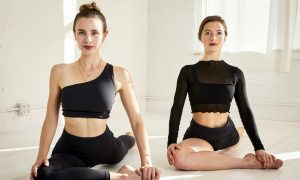By Emily C. Harrison MS, RD, LD
of The Centre for Dance Nutrition.
www.dancernutrition.com
As a dietitian for dancers and a former professional dancer myself, I get lots of emails. Many of these questions are about some common dancer myths that I remember from when I was in the school and the company. Here we take a deeper look at some of these and try to separate fact from fiction.
Dear Dietitian: “I am a 17-year-old female ballet dancer (5’4″) and I have struggled within the last year in knowing what a healthy weight is for my body. I read online that ballet dancers should be 10 lbs. lighter than a healthy BMI for normal people, despite the fact that their muscle weighs more than fat. Is a BMI of 20.4 (over 120 lbs.) overweight if I wanted to get into a company?”
The term “BMI” refers to a calculation of someone’s height to their weight. I haven’t heard that ballet dancers have to be 10 lbs. lighter than a healthy BMI. This is one of those dancer myths. Healthy BMI is a big range and beautiful, successful, professional dancers come in all shapes and sizes. There is not a correct weight or BMI that dancers have to fit, and BMI doesn’t take into account muscle mass.
Successful ballet dancers are lean and muscular because they regularly make smart, healthy choices, not because they starve themselves to fit some arbitrary calculation or number on a scale. They know that they can’t eat junk, fast food or drink soda. Real professional dancers know that if they want to look good in tights, they have to fuel the body well with healthy food. It’s possible to eat well and still have a great career. Dancers shouldn’t define their potential for success by a number on a scale, but instead focus on hard work in the studio and smart food and beverage choices outside the studio.
Dear Dietitian: “I am 23 years old and I just got a company contract, but this past season my energy levels have been terrible and I am having trouble feeling strong at the end of class. I have tried eating more protein and less carbs, but it’s not working. Should I increase my protein before class?”
Energy levels depend on many factors. First, don’t go for more than three hours without eating. Never dance on an empty stomach. Second and most important, carbohydrate or “carbs” are the preferred source of energy for any athletic activity. The body likes to save protein for rebuilding muscle after exercise, maintaining fluid balance and many other biological processes. Eating protein and no carbs before dance is a great way to feel exhausted. Eat complex carbs like whole grains, fruits and vegetables. Try a bowl of oatmeal/porridge before class.
Energy levels can also be affected by hydration. Are you getting approximately 2800 ml (10-12 cups) of water per day? If not, make sure your water bottle goes everywhere with you and refill often.
Nutrition status can affect energy levels. Are you getting enough vitamins and minerals? B-vitamins and Iron are just two examples of nutrients that contribute to energy levels. If low energy persists, let your doctor know so he/she can rule out anything medical or food allergy related. Now get some good sleep and keep dancing.
Dear Dietitian: “I am 15 years old and am in school during the day and dance in the evenings for 3-6 hours each day. It’s late by the time I finally get home after dance and I have lots of homework so I don’t eat much. I heard other dancers say that you shouldn’t eat after 8 p.m. anyway. Is that true?”
It is a myth that you shouldn’t eat past a certain time at night. Those calories don’t “turn into fat” just because you are going to bed soon. This is a critical time for muscle building, so eat something even if it’s small and quick. The body doesn’t shut down at night. You need nutrients even when sleeping. You have been dancing hard in class and rehearsal so you need to provide the building blocks for repair and strengthening if you want to improve.
An example post-dance meal might be some bean and veggie soup and a whole grain roll or quinoa. Rice, veggies and soy are easy, or you could have a sandwich and/or a salad with garbanzo beans with a glass of soy, flax or almond milk. Avoid the temptation to stop by fast food on the way home and get a calorie bomb meal. Instead make smart choices. You will gain strength faster if you provide nutrients post-exercise.
For more letters to the dietitian related to these topics, see www.dancernutrition.com/ask-the-dietitian.html and feel free to send your own questions to the dietitian.
Emily Harrison
 Emily Cook Harrison MS, RD, LD
Emily Cook Harrison MS, RD, LD
Emily is a registered dietitian and holds both a bachelor’s and master’s degree in nutrition from Georgia State University. Her master’s thesis research was on elite level ballet dancers and nutrition and she has experience providing nutrition services for weight management, sports nutrition, disordered eating, disease prevention, and food allergies. Emily was a professional dancer for eleven years with the Atlanta Ballet and several other companies. She is a dance educator and the mother of two young children. She now runs the Centre for Dance Nutrition and Healthy Lifestyles. She can be reached at emily@dancernutrition.com www.dancernutrition.com
Photo (top): © Photographerlondon | Dreamstime.com















